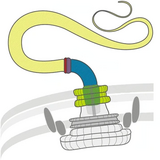| Part of a series on |
| Microbial and microbot movement |
|---|
 |
| Microswimmers |
| Molecular motors |
Robotic sperm (also called spermbots) are biohybrid microrobots consisting of sperm cells and artificial microstructures.[1][2][3] Currently there are two types of spermbots. The first type, the tubular spermbot, consists of a single sperm cell that is captured inside a microtube. Single bull sperm cells enter these microtubes and become trapped inside. The tail of the sperm is the driving force for the microtube.[1] The second type, the helical spermbot, is a small helix structure which captures and transports single immotile sperm cells. In this case, a rotating magnetic field drives the helix in a screw-like motion. Both kinds of spermbots can be guided by weak magnetic fields.[2] These two spermbot designs are hybrid microdevices, they consist of a living cell combined with synthetic attachments. Other approaches exist to create purely synthetic microdevices inspired by the swimming of natural sperm cells, i.e. with a biomimetic design, for example so-called Magnetosperm which are made of a flexible polymeric structure coated with a magnetic layer and can be actuated by a magnetic field.[4]
- ^ a b Magdanz, Veronika; Sanchez, Samuel; Schmidt, Oliver G. (2013). "Development of a Sperm-Flagella Driven Micro-Bio-Robot". Advanced Materials. 25 (45): 6581–6588. doi:10.1002/adma.201302544. PMID 23996782.
- ^ a b Medina-Sánchez, Mariana; Schwarz, Lukas; Meyer, Anne K.; Hebenstreit, Franziska; Schmidt, Oliver G. (2016). "Cellular Cargo Delivery: Toward Assisted Fertilization by Sperm-Carrying Micromotors". Nano Letters. 16 (1): 555–561. Bibcode:2016NanoL..16..555M. doi:10.1021/acs.nanolett.5b04221. PMID 26699202.
- ^ Magdanz, Veronika; Medina-Sánchez, Mariana; Schwarz, Lukas; Xu, Haifeng; Elgeti, Jens; Schmidt, Oliver G. (2017). "Spermatozoa as Functional Components of Robotic Microswimmers". Advanced Materials. 29 (24): 1606301. doi:10.1002/adma.201606301. PMID 28323360.
- ^ Khalil, Islam S. M.; Dijkslag, Herman C.; Abelmann, Leon; Misra, Sarthak (2014). "MagnetoSperm: A microrobot that navigates using weak magnetic fields". Applied Physics Letters. 104 (22): 223701. Bibcode:2014ApPhL.104v3701K. doi:10.1063/1.4880035.